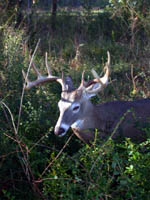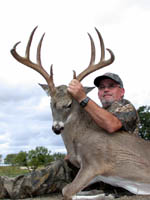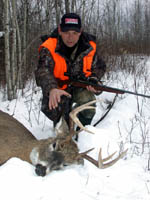
|
Features
|
|
|
|
Books
|
|
|
|
Fun & Games
|
|
|
|
Contact Us
|
|
|
John's Journal... Entry 223, Day 4
THE FEAR FACTOR: HOW MUCH HUNTING PRESSURE CAN A BUCK STAND?
What Hunters Can Do To Reduce Pressure And Increase Deer Sightings And Hunting These Pressured Bucks
 The
only way to eliminate hunting pressure is to reduce the number of hunters
who hunt any given piece of property or reduce the number of times each
hunter goes onto that land. However, our experts have some creative alternatives
to reduce hunter pressure on the land you hunt. Bob Foulkrod suggests
that, “If you’re in a hunting club with 20 members, try and
reduce that number to 10. Then fewer people will be pressuring and attempting
to take the same number of deer. A better solution may be to hunt posted
property. I don’t mean you should violate the law of trespass. However,
I look for posted property. Then I go to the landowner, talk to him about
why he’s posted his property and convince him I’m not the
type of hunting slob who has caused him to put up the No Trespassing signs.
Often talking to the landowner may help you gain permission to hunt posted
property no one else can hunt. You may find and develop a deer-hunting
hot spot by simply being courteous to the landowner.”
The
only way to eliminate hunting pressure is to reduce the number of hunters
who hunt any given piece of property or reduce the number of times each
hunter goes onto that land. However, our experts have some creative alternatives
to reduce hunter pressure on the land you hunt. Bob Foulkrod suggests
that, “If you’re in a hunting club with 20 members, try and
reduce that number to 10. Then fewer people will be pressuring and attempting
to take the same number of deer. A better solution may be to hunt posted
property. I don’t mean you should violate the law of trespass. However,
I look for posted property. Then I go to the landowner, talk to him about
why he’s posted his property and convince him I’m not the
type of hunting slob who has caused him to put up the No Trespassing signs.
Often talking to the landowner may help you gain permission to hunt posted
property no one else can hunt. You may find and develop a deer-hunting
hot spot by simply being courteous to the landowner.”
 Dr.
Causey recommends you specify the times of day you hunt to help reduce
hunter pressure. “If for instance, your hunting club has imposed
a rule that all hunters must be in the woods before daylight, not leave
the woods until 10:00 a.m., must be out of the woods by 10:30 a.m., cannot
reenter the woods until 2:00p.m., and then must wait to leave the woods
after dark, you drastically will reduce the amount of hunter movement
in the woods except for those periods. This strategy will reduce hunter
encounters with deer. I believe reducing the amount of vehicular activity
and hunter activity during specific times can reduce the amount of pressure
the deer feels.”
Dr.
Causey recommends you specify the times of day you hunt to help reduce
hunter pressure. “If for instance, your hunting club has imposed
a rule that all hunters must be in the woods before daylight, not leave
the woods until 10:00 a.m., must be out of the woods by 10:30 a.m., cannot
reenter the woods until 2:00p.m., and then must wait to leave the woods
after dark, you drastically will reduce the amount of hunter movement
in the woods except for those periods. This strategy will reduce hunter
encounters with deer. I believe reducing the amount of vehicular activity
and hunter activity during specific times can reduce the amount of pressure
the deer feels.”
Brad Harris feels often outdoorsmen exert too much hunting pressure on the deer before hunting season opens. “Even scouting creates hunting pressure,” Harris mentioned. “When you go in the woods a week or two weeks before hunting season to scout, you’re letting the buck know you’re there and teaching him to prepare for hunting season. I do my scouting before summer when the deer are in the velvet and still walking in open places. I use binoculars and try to stay as far away from the deer as I can. Once I’ve spotted the buck I want to bag, I’ll wait until the week before the peak of the rut to attempt to take that deer. That’s when bucks are usually moving the most and are the easiest to locate and bag. Scouting from long range reduces hunting pressure and increases your odds for bagging a buck.”
 The
Best Area And Time To Hunt Pressured Bucks
The
Best Area And Time To Hunt Pressured Bucks
Bucks that feel the effects of hunting pressure will hole up where deer hunters are not. If you want to take an older, trophy buck this season, study an aerial photo or topo map, and hunt five or six areas where other hunters never go. These spots may include thickets, islands, a berry patch behind the hunting lodge, the edge of a road leading to camp, a little shelf off the edge of a cliff or a thigh-high swamp. “Once you understand where to hunt, determining the best time to hunt is relatively easy,” Foulkrod said. “The deer know that most hunters hunt from daylight to 10:00 or 11:00 a.m. and from 2:00 p.m. until an hour before dark. The prime time for you to hunt a buck that has dodged all the other hunters is in the middle of the day and during the last hour of daylight.” Causey relates a story of a colleague who has developed a simple method, which has produced bucks for him in high-pressure areas. “My hunting friend lets everyone on the lease he hunts decide where they prefer to hunt each morning. After everyone else has picked out the ‘good places,’ he goes to the worst hunting spots left on the land. But often he bags better bucks in these areas because these animals aren’t receiving much hunting pressure.”
 Dr.
Sheppard believes the best time to hunt a high-pressure buck is the last
week of the season. “Before bow season, I go to thickets and cut
shooting lanes, 2 to 3 feet wide and 10- to 25-yards long inside each
thicket. Then the last week of the season, I move into these thickets
with a favorable wind and watch the shooting lanes. By the end of the
season, the older-age-class bucks have to be in the thickets to survive.
If they’re in those thickets, sooner or later they have to cross
shooting lanes. When they do, I bag them.” Harris tries to pattern
hunters to take older-age-class bucks. “By the end of the season,
I’ll usually know where and when people are hunting. Then I get
in the woods before the hunters arrive and stay in the woods until after
they leave. This way I’m using hunter pressure to move deer to me
so I can get a shot.”
Dr.
Sheppard believes the best time to hunt a high-pressure buck is the last
week of the season. “Before bow season, I go to thickets and cut
shooting lanes, 2 to 3 feet wide and 10- to 25-yards long inside each
thicket. Then the last week of the season, I move into these thickets
with a favorable wind and watch the shooting lanes. By the end of the
season, the older-age-class bucks have to be in the thickets to survive.
If they’re in those thickets, sooner or later they have to cross
shooting lanes. When they do, I bag them.” Harris tries to pattern
hunters to take older-age-class bucks. “By the end of the season,
I’ll usually know where and when people are hunting. Then I get
in the woods before the hunters arrive and stay in the woods until after
they leave. This way I’m using hunter pressure to move deer to me
so I can get a shot.”
TOMORROW: PREVENT A BUCK FROM SEEING, SMELLING OR HEARING YOU, THEREBY DECREASING HUNTER PRESSURE
Check back each day this week for more about THE FEAR FACTOR: HOW MUCH HUNTING PRESSURE CAN A BUCK STAND?...
Day 1 - Fear of Dogs Moves
Deer
Day 2 - How Deer Learn To Fear Man
Day 3 - Amount Of Human Contact A Buck Can
Stand Before Reducing Movement And Nocturnal Deer
Day 4 - What Hunters Can Do To Reduce Pressure
And Increase Deer Sightings And Hunting These Pressured Bucks
Day 5 - Prevent A Buck From Seeing, Smelling
or Hearing You, Thereby Decreasing Hunter Pressure